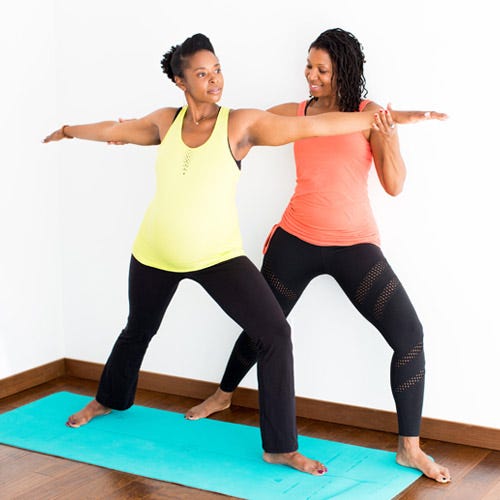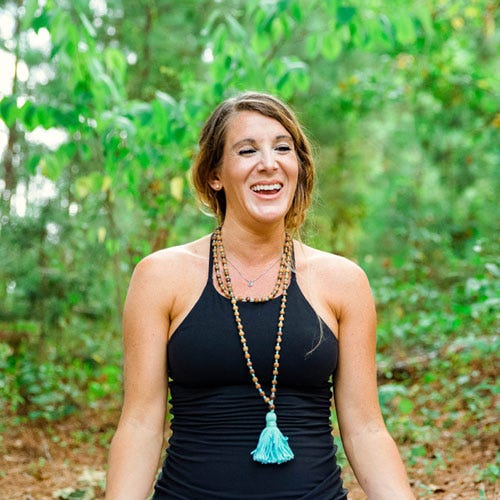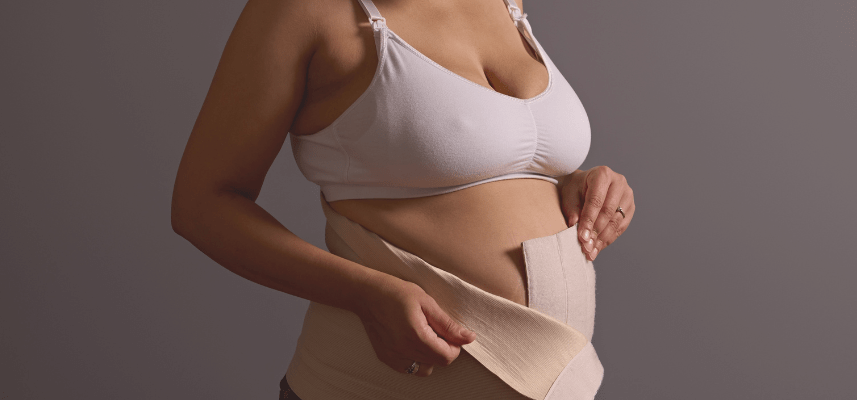September is National Yoga Month and we’re celebrating with some expert tips for pregnant mamas! For experienced yogis who want to continue their practice during pregnancy, or for newbies who are just starting out, prenatal yoga is a wonderful, low-impact way to improve strength and flexibility. It’s also well suited to prepare moms for labor and delivery. Yoga helps mom quiet the mind, connect to breath, and direct focus to the body and all the new sensations that come with pregnancy.
There are many forms of yoga and the practice is customizable for varying fitness levels, which makes it easy to modify to accommodate a growing belly and shifting center of gravity. After the first trimester, many moms find that the added weight and pressure on the pelvic floor can make exercise, including yoga, more challenging. Pay attention to your body’s signals and make sure to focus on the most supportive poses for each stage of your pregnancy. Adding in props like blocks and straps may also be necessary as your body changes, and a pregnancy support band will help relieve some of the pressure on your abdomen, lower back, hips, and pelvis. As with any exercise habit, it’s a good idea to check with your doctor before starting a new regimen while you're pregnant.
While heading over to your local yoga studio for some in-person classes may not be possible right now, the good news is that there are plenty of classes available online. Read on for more information on what to know and how to get the most out of your prenatal yoga practice!
Elika Aird
I generally encourage clients to explore the balance of movement and stillness throughout their pregnancy, to their comfort. I generally recommend that mamas dance, hike, swim and, of course, do yoga!
For those wishing to continue their yoga practice to cultivate more ease in pregnancy/labor, I would encourage them to try to do 2-4X days of practice weekly (30-60 mins). Half of the time being more active (solar) and the other half being restful (lunar). The Warrior pose shown here would be an example of a Solar pose you could hold for 5 - 10 breaths on each side. The reclining pose would be a lunar pose. To alleviate back pain or rest deeply, use pillows/blankets to support the spine (in an inclined position) and place feet together. Slowly recline and rest 5-15 mins.
While it is important to stay active, it's advised to not make any drastic changes to your physical practices in the first trimester. However, Prenatal or a Gentle Yoga class is generally suitable for a new practitioner without any major injuries. I would find a prenatal yoga class online or a DVD to try out to make sure you are doing all the poses correctly.
Bio: Elika Aird is a Registered Yoga Teacher/Birth Doula with almost 20 years sharing her passion for health + wellness and working with people of every population. Starting as a personal trainer in Atlanta, she now offers various styles of yoga and meditation to support a balanced mind and body throughout gyms, corporations, and studios around the Bay Area including Anasa Yoga based in East Oakland. She is a Prana Vinyasa-trained instructor and specializes in Pre+Postnatal Yoga and offers Birth Education + Empowerment classes. Learn more about Elika and her classes at BlissfulBodiesYoga.com. Follow along on Instagram @blissfulbyoga and Facebook. For information on Anasa Yoga classes, visit AnasaOakland.com. Follow along on Instagram @anasayoga and Facebook.
Kelly Bryant
The most important thing to remember as you begin or continue your yoga practice is that your body right now is different than it always has been or ever will be. Every morning you are waking up in a new body, and you have to practice for the body that shows up on the mat today. This is always true, but especially in pregnancy: you should use all the props you need to achieve the intended benefit of the pose (which, hopefully, your teacher will tell you!), you can take breaks whenever and however you want, and you can always do something different than what is being taught. This is an incredible time to practice listening to what your body wants to say.
Bio: Kelly Bryant is a Yoga Alliance Experienced Registered Yoga Teacher and Registered Prenatal Yoga Teacher, Certified Personal Trainer, and a realist. She is committed to helping women understand their bodies — specifically their core and pelvic health — and adopt a mindset around movement that addresses physical and psychological components. She is passionate about empowering women through all stages of life from prenatal to postpartum to take care of themselves so that they can show up and do their work in the world.
Carina Devi
One of the greatest benefits of yoga during pregnancy isn’t the strength or suppleness your muscles will enjoy, but the tools for inner peace you will cultivate. You can most likely continue much of your regular yoga practice, but stay away from poses that engage your rectus abdominis (those are your six-pack muscles). Boat and Plank pose are two that should be avoided. And of course, as your belly grows, you’ll want to avoid any poses that have you lying down on your belly, like Locust pose.
Yoga sequences that strengthen the upper body and legs, and that open the hips are the best to focus on. Warrior, Triangle, and Goddess poses are wonderful for keeping your hips open and legs strong. Many poses that require you to lie on your back can be done lying on your side instead, or even standing. For example, Figure 4 pose is wonderful for opening your hips, but if it’s uncomfortable to lie on your back, you can always practice while standing or sitting in a chair.
Yoga teaches that you can withstand the storms of life, that discomfort won’t take you down, and that you can lean into your breath anytime you need (and mothering will offer plenty of opportunities to practice). Lean into your yoga practice, Mama, and it will support you in endless, invaluable ways.
Bio: Carina Devi is a prenatal yoga teacher, birth doula, and Head of Mindfulness for Mindful Mamas, a new mindfulness and self-care app designed for moms and moms-to-be. Learn more at MindfulMamasApp.com and follow @mindfulmamasclub and @carina.devi.
Genevieve Boulanger
Pregnancy is a time to take genuine care of yourself (and baby). Find a teacher that inspires you and excites you on the path to good health. Prenatal Yoga is a way for mother and baby to feel the bond of connection being forged with the practice of focused breath. If you prefer to practice at home, consider trying online resources like YouTube. Or, look for studios in your area that offer virtual classes for expectant mothers. We offer one class per week to our mommies and there is a real community of support there.
Bio: Genevieve has been practicing holistic health and wellness since she was a child, attending her first yoga class at age six. Her passion for a sustainable yoga practice comes from having a hippy Mother who encourages 'deep breathing' over traditional medicine. Genevieve grew up studying classical ballet where a genuine connection with the body is necessary in finding grace. When Genevieve is not on her mat, you can find her with her camera – capturing Love & Light. Learn more at iShine Yoga and follow @loveandlightphotography.
Karen Zelinsky
Yoga is a great way to stay active and comfortable during pregnancy, and prepare the body and mind for labor. It’s important to know which yoga poses are best for the pregnancy and which to avoid. Consider finding a certified prenatal yoga teacher to help with this. Poses that are great for pregnancy are poses that focus on the back and hips, like downward facing dog, cat/cow and squatting. Standing poses such as goddess and warrior II strengthen your legs and help focus the mind and teach you how to breathe through holding a pose – great practice for labor.
When you begin, be ready with plenty of props – blocks, a strap and a bolster will be helpful, but you can find things around your house that will substitute such as a bathrobe belt, pillows and blankets. Sitting up on something like a cushion or blanket helps to lengthen the spine, which helps with back pain and creates space in the torso, making it easier to breathe. Generally pregnant women should avoid inversions, twists and prone positions. A prenatal yoga teacher may make exceptions to these rules but if you’re practicing on your own it’s best to follow that advice.
Bio: Karen Zelinsky is a birth doula, postpartum doula, HypnoBirthing instructor, childbirth educator, yoga teacher and mom. Karen has been teaching prenatal yoga since 2005. Currently Karen offers prenatal yoga classes on Zoom through The Gentle Place in Framingham.
Information provided in blogs should not be used as a substitute for medical care or consultation.













